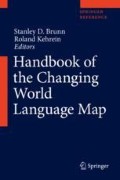Abstract
Language, as an important cultural element, is the main index of regional cultural geography. The folk music influenced by local language is also one of the elements to study regional cultural changes. By analyzing the basic features of Mongolian music in Ordos region of China in the early twentieth century, this chapter finds that the local Mongolian music is deeply influenced by Han immigrant culture in this period. Although the long-tune music, a traditional main narrative form, remained in daily life and festival activities, it began to show a decline, while the short-tune music with lively rhythm was very popular under deep influence of the Han folk music. At the same time, under the introduction of Catholicism, the folk music from Belgium also began to be a part of the Mongolian folk music. The change of Mongolian music in Ordos reflects the originally single Mongolian soundscape of Ordos began to present complex and diverse regional features made by cultural contact and communication in the process of social great changes.
Access this chapter
Tax calculation will be finalised at checkout
Purchases are for personal use only
References
“Inner Mongolia”. (1985). Editorial committee of Inner Mongolia agricultural geography eds., Inner Mongolia agricultural geography. Inner Mongolia People’s Publishing House.
Ku, W. (Ed.). (2002). Mission beyond the Great Wall, Leuven: Ferdinand Verbiest Foundation. Taipei: Kuangchi Cultural Group.
“Summary”. (1932). Summary of Shaanxi and Suiyuan’s division of provincial boundaries, Jingxiuzhai.
Tao, J. (2003). Migration process and its analysis in Hetao area from Qing dynasty to early republic of China. Inner Mongolia Social Sciences, 5, 26–30.
Van Oost, J. (1908). Recueil de chansons mongoles. Anthropos, 3(2), 219–233.
Van Oost, J. (1912). Chansons populaires chinoises de la région Sud des Ortos. sur la lisière de la grande muraille entre Ju-lin et Hoa-ma-tch’e. Anthropos, 7(4), 893–919.
Van Oost, J. (1914, April 20). Chinois et Mongols. Leur Musique. Le Devoir, Montreal.
Van Oost, J. (1915). La musique chez les Mongols des Urdus. Anthropos, 10–11(3–4), 358–396.
Van Oost, J. (1922a). Vingt Cantiques sur textes Chinoises avec accompagnement d’orgue. Shanghai: Zikawei.
Van Oost, J. (1922b). Chapitre V: Chansons et musique Populaires. In: Notes sur le T’oumet. Chang-hai: Imprimerie de la Mission catholique.
Van Oost, J. (1930). Les musiciens professionels dans le Nord de la Chine. La Revue Belge, 544–555.
Van Oost, J. (1932). Chapitre VIII: La Chanson Populaire. In: Au Pays des Ortos. Paris: Dillen.
Van Overmeire, D. (Ed.) (2008). Elenchus of CICM in China, 1865–1955. Taipei: Jianzheng monthly.
Zhang, X. (2017). How to listen: The origin and development of soundscape research, Wenhui Daily, W12, March 31, 2017.
Zhou, Q. (Ed.) (1993). Historical geography of Inner Mongolia. Hohhot: Inner Mongolia University Press.
Zhuang, H. (2017). Study of the spread of Catholicism in Mongolia and its environmental adaption from the Qing dynasty to the republic of China. Unpublished Ph.D Dissertation, Fudan University.
Publisher’s note:
Springer Nature remains neutral with regard to jurisdictional claims in published maps and institutional affiliations.
Author information
Authors and Affiliations
Corresponding author
Editor information
Editors and Affiliations
Rights and permissions
Copyright information
© 2020 Springer Nature Switzerland AG
About this entry
Cite this entry
Zhang, X., Zhuang, H. (2020). Language/Music Contacts and Exchanges: Nomadic Mongolian Music Transformations in Ordos Area in the Early Twentieth Century. In: Brunn, S., Kehrein, R. (eds) Handbook of the Changing World Language Map. Springer, Cham. https://doi.org/10.1007/978-3-030-02438-3_198
Download citation
DOI: https://doi.org/10.1007/978-3-030-02438-3_198
Published:
Publisher Name: Springer, Cham
Print ISBN: 978-3-030-02437-6
Online ISBN: 978-3-030-02438-3
eBook Packages: Social SciencesReference Module Humanities and Social SciencesReference Module Business, Economics and Social Sciences

